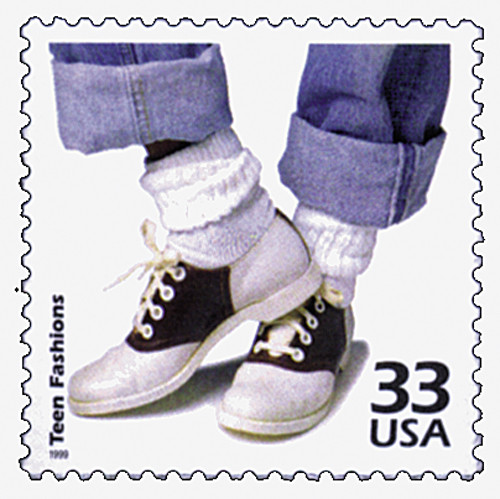
# 3187g - 1999 33c Celebrate the Century - 1950s: Tail Fins & Chrome
US #3187g
1999 Tail Fins and Chrome – Celebrate the Century (1950s)
• Part of the sixth sheet in the Celebrate the Century stamp series issued from 1998-2000
• Commemorates the iconic cars of the 1950s
• Includes text on the back with historical details
Stamp Category: Commemorative
Series: Celebrate the Century
Value: 32¢ First Class Mail Rate
First Day of Issue: May 26, 1999
First Day City: Springfield, Massachusetts
Quantity Issued: 188,000,000
Printed by: Ashton Potter (USA) Ltd.
Printing Method: Offset, Intaglio
Format: Panes of 15
Perforations: 11.5
Tagging: Block Tagging
Why the stamp was issued: To honor the ornate car designs with chrome, tail fins, and bright colors that were popular during the 1950s.
About the stamp design: Pictures artwork by Dean Ellis of the back end of a 1957 Chevrolet Bel Air. Includes the following text on the back: “Cars of the ‘50s were large and ornate. Automakers attracted buyers with annual styling changes. Tail fins, dazzling grilles, chrome trim, and hardtop convertibles were popular, as were big V-8 engines and three-toned paint jobs.”
First Day City: The First Day of Issue Ceremony was held at the Civic Center in Springfield, Massachusetts, the hometown of Dr. Seuss.
About the Celebrate the Century series: The USPS launched the Celebrate the Century series in 1998 to mark the end of the 20th century and herald the arrival of the 21st. The series includes 10 sheets of 15 stamps (150 in total), with each honoring important moments from a different decade (1900s, 10s, 20s, 30s, 40s, 50s, 60s, 70s, 80s, and 90s). At the time of completion, it was the longest and most ambitious commemorative stamp series in US history.
History the stamp represents: With shiny silver chrome, flowing tail fins, and bright color schemes, cars of the 1950s represent a time in American history which has been called the “era of excess.” It was during this decade that cars became longer, wider, and lower. The American love affair with the automobile was stronger than it had ever been.
One distinguishing feature of 1950s automobiles was the tail fin. Chrysler designers were responsible for turning the tail fin fad into a national phenomenon. It was on the company’s 1957 models that the fins received attention, and competing manufacturers quickly duplicated the look. The craze later got out of hand when in 1960, a tail fin on a Chrysler model stretched as far as the front door.
Automobile styling features included futuristic-looking dashboards, which displayed speed and fuel level. To give cars a streamlined look, wraparound rear windows were added. Chrome grilles spanned the entire front end of the car. Fuel injection and increased horsepower improved the engine.
The 1957 Chevrolet Bel Air was arguably the decade’s most distinctively styled car. It had a massive grille connected to the bumper, prominent fins, and was four inches longer than the previous year’s model.
US #3187g
1999 Tail Fins and Chrome – Celebrate the Century (1950s)
• Part of the sixth sheet in the Celebrate the Century stamp series issued from 1998-2000
• Commemorates the iconic cars of the 1950s
• Includes text on the back with historical details
Stamp Category: Commemorative
Series: Celebrate the Century
Value: 32¢ First Class Mail Rate
First Day of Issue: May 26, 1999
First Day City: Springfield, Massachusetts
Quantity Issued: 188,000,000
Printed by: Ashton Potter (USA) Ltd.
Printing Method: Offset, Intaglio
Format: Panes of 15
Perforations: 11.5
Tagging: Block Tagging
Why the stamp was issued: To honor the ornate car designs with chrome, tail fins, and bright colors that were popular during the 1950s.
About the stamp design: Pictures artwork by Dean Ellis of the back end of a 1957 Chevrolet Bel Air. Includes the following text on the back: “Cars of the ‘50s were large and ornate. Automakers attracted buyers with annual styling changes. Tail fins, dazzling grilles, chrome trim, and hardtop convertibles were popular, as were big V-8 engines and three-toned paint jobs.”
First Day City: The First Day of Issue Ceremony was held at the Civic Center in Springfield, Massachusetts, the hometown of Dr. Seuss.
About the Celebrate the Century series: The USPS launched the Celebrate the Century series in 1998 to mark the end of the 20th century and herald the arrival of the 21st. The series includes 10 sheets of 15 stamps (150 in total), with each honoring important moments from a different decade (1900s, 10s, 20s, 30s, 40s, 50s, 60s, 70s, 80s, and 90s). At the time of completion, it was the longest and most ambitious commemorative stamp series in US history.
History the stamp represents: With shiny silver chrome, flowing tail fins, and bright color schemes, cars of the 1950s represent a time in American history which has been called the “era of excess.” It was during this decade that cars became longer, wider, and lower. The American love affair with the automobile was stronger than it had ever been.
One distinguishing feature of 1950s automobiles was the tail fin. Chrysler designers were responsible for turning the tail fin fad into a national phenomenon. It was on the company’s 1957 models that the fins received attention, and competing manufacturers quickly duplicated the look. The craze later got out of hand when in 1960, a tail fin on a Chrysler model stretched as far as the front door.
Automobile styling features included futuristic-looking dashboards, which displayed speed and fuel level. To give cars a streamlined look, wraparound rear windows were added. Chrome grilles spanned the entire front end of the car. Fuel injection and increased horsepower improved the engine.
The 1957 Chevrolet Bel Air was arguably the decade’s most distinctively styled car. It had a massive grille connected to the bumper, prominent fins, and was four inches longer than the previous year’s model.














